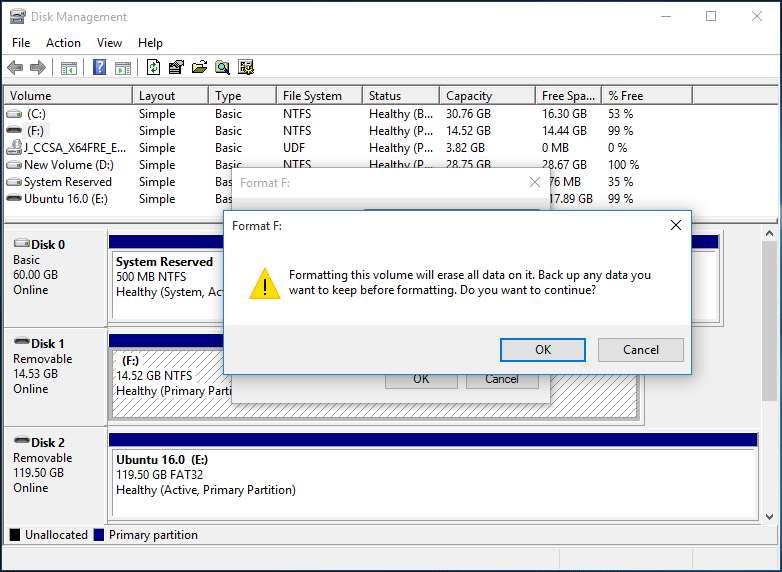

- #RASPBERRY PI DISK FORMATTING HOW TO#
- #RASPBERRY PI DISK FORMATTING INSTALL#
- #RASPBERRY PI DISK FORMATTING UPDATE#
- #RASPBERRY PI DISK FORMATTING PASSWORD#
- #RASPBERRY PI DISK FORMATTING PLUS#
I looked through it but decided to follow this guide using parted to format the disk from the command line.
#RASPBERRY PI DISK FORMATTING INSTALL#
I started from the official Raspberry Pi Install Docs and that eventually linked me out to this blog by Norman Dunbar.
#RASPBERRY PI DISK FORMATTING PASSWORD#
Enter the address “\\piCoreLMS\LMSfiles” and then username “tc” and the password that you assigned to Samba at the end of step 6. I am repurposing one of my Raspberry Pi’s and need to format the microSD card. Right-click on ThisPC and select “Add a network location”. On your Windows PC, launch Windows Explorer. When this has completed, return to the previous page. Scroll down to the “Setup Samba Share” section and enter a value for “Password”, then click on “Set Password”. When this has completed, scroll down to the “Setup Samba Share” section and enter values for “Server Name”, piCoreLMS “Share Name”, LMSfiles “Share Path”, /mnt/LMSfiles and “Create File Mode”, 0775 then click on “Set Samba” In either case, select “LMS” from the menu bar, and scroll down to the “Setup Samba Share” section, and click on “Install”. Having completed the setup, you should now be able to play audio from the piCoreLMS to the internal piCorePlayer.Īpply power to your Raspberry Pi and wait for it to boot up and connect to the network. Unless you wish to set up a mysqueezebox account, skip the first LMS set up screen, then select your music and playlist locations on your USB disk. In “Logitech Media Server (LMS) operations” select “Configure LMS”. Scroll down to “Save LMS Server Cache and Preferences to Mounted Drive” click on the “Enabled” radio button next to USB Disk and click on “Move LMS Data” All you have to do now is to name the mount point, click on the “Enabled” radio button and then click on “Set USB Mount”. You should note that your USB disk has been automatically detected.
#RASPBERRY PI DISK FORMATTING PLUS#
The first thing we need to do before we can access HFS Plus drives is to ensure our Raspberry Pi is running up to date software. In either case, select “LMS” from the menu bar, and scroll down to the “Pick from the following detected USB disks to mount” section. Adding support for HFS On your Raspberry Pi. You should now be back at the “Welcome” or “Main Page” screen. Start the browser, and enter the IP address assigned to the Pi, this will usually be the same as the address you used previously, but if not use Advanced IP Scanner to obtain the new address as previously described. Remove the power from your Raspberry Pi, Plug-in the USB disk, re-apply the power and wait for your Pi to boot up and connect to the network. Step 2 - Adding an USB Hard Disk - Execution Now is a good time to backup and reboot your piCorePlayer, so return to the “Main Page” and then “Backup” and “Shutdown” In any case you will need to set up two directories on your USB hard disk for later use by LMS, these directories that will contain your music and playlists I have imaginatively set them up as “music” and “playlists” (ahem!).

Windows users can pre-format such a disk using the free utility MiniTool Partition Manager, and this is in fact what I have done.Īppropriate directories can then be set up on the EXT4 disk from Windows using the free version of Extfs for Windows from Paragon software. Note that this step is not required if your disk is formatted as EXT4. If the USB hard disk you are adding is formatted as FAT32 or NTFS you will need to install the “additional Filesystems pack” before you can load and configure the disk.
#RASPBERRY PI DISK FORMATTING HOW TO#
Also if anyone knows how to submit a patch to the Raspberry Pi docs please let me know.SAMBA Step 1 - Adding an USB Hard Disk - Preparation I’m honestly not sure why this causes such a speed decrease (and it’s definitely worth looking into). Rdiskn is the actual name of the disk which diskn points to. Raspberry pi wifi dongle (you can also use Ethernet).

SD card for the raspberry pi operating system. The work around is pretty straight forward: For this instructable you will need: Raspberry pi (Im using a model B) Another computer if you want to SSH into your pi. However, I finally discovered the culprit.Īpparently on OS X the disk2s1 name is actually some sort of pointer or symlink to actual name of the drive. Most answers were something along the lines of “Your SD card reader is probably broken”. Searching around yielded very little help.
#RASPBERRY PI DISK FORMATTING UPDATE#
Quick Pro-tip: You can bonk ctrl+t while the drive is formatting and get a status update from dd. I let the device format for about an hour before I just gave up. I was following the official flashing instructions and I was having real problems with the speed. Part of the process in setting up a Pi is that you need to flash a SD with one of a

I just got a Raspberry Pi 2 for me and my daughter to hack around on.


 0 kommentar(er)
0 kommentar(er)
